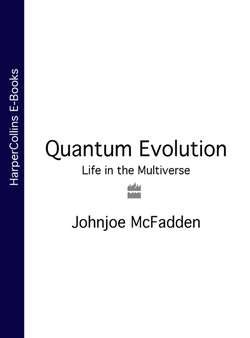Читать книгу Quantum Evolution: Life in the Multiverse - Johnjoe McFadden - Страница 24
HOW DNA WORKS
ОглавлениеThe key to Watson and Crick’s structure is the order and pairing of the nucleic acid bases. The backbone of each DNA molecule is a string (polymer) of deoxyribose sugars, linked by phosphate groups. Each sugar has a single base attached that can be one of four bases, guanine (G), cytosine (C), thymine (T) or adenine (A). Running down the length of a single DNA strand you can therefore read a linear sequence of bases, such as ATCCGTACCTGAACATAACCGATT… Codes were not unfamiliar in post-war England, particularly to Crick who during the war had worked as a scientist for the Admiralty. The linear sequence of bases looked like a code: the genetic code. Watson and Crick suggested that the sequence of bases codes for the structure of proteins. By the 1950s it was known that proteins performed nearly all the work of making living cells. In particular, enzymes which make everything else DNA, RNA, fats, sugars, polysaccharides – the complete living cell – are proteins. If DNA encoded the information to make proteins, and proteins made everything else, then the problem of how cells know what to make would be solved.
Over the next decade the code was cracked, confirming that DNA sequences did indeed code for proteins. Proteins are linear polymers of amino acids (another group of simple organic acids). There are twenty common amino acids that go into proteins but only four bases that go into DNA. There cannot therefore be a one-to-one coding between a DNA base and an amino acid. It was not long before experiments performed by Marshal Nirenberg, Gobind Khovana and Severo Ochoa established that a triplet of bases, called a codon, encodes each amino acid. The codon GCC for instance codes for the amino acid alanine, whilst GGC codes for glycine. A protein made of only 1,000 alanine amino acids would have a genetic code consisting of 1,000 codons (3,000 bases); each codon being the sequence GCC, generating a DNA sequence GCC GCC GCC GCC GCC… All natural proteins are far more complex than this and are encoded by a more complex code; but the principle is the same.
This was the answer to one of life’s great puzzles: how biological information is encoded and stored inside living cells. The DNA sequence encodes the sequence of proteins and the proteins make everything else (even DNA itself – a curious example of self-reference which is one of the intriguing features of life). By directing the synthesis of proteins, the DNA molecule is able to orchestrate all the activities of the entire cell – and thus the entire body. This is how a dog cell knows how to make a dog, how an oak cell knows how to make an oak tree or how a human cell knows how to make us. Each cell carries its own DNA molecule within it with a unique sequence of bases, encoding the essential dogginess, oakiness, or humanness of us all.
In their historic paper’s last line, Watson and Crick suggested that DNA’s structure also provided a solution to the other great mystery of life, how biological information is passed on from one generation to the next – or why you look like your daddy. A major feature of the double helix is that wherever a base occurs on one strand of the DNA, a complementary base is found on the opposite strand: A is paired with T and G is paired with C. The pairs of complementary bases are held together by a hydrogen bond, a type of chemical bond. Chapter Five will look at chemical bonds in more detail, but a hydrogen bond is held together by the electromagnetic force existing between a positively charged proton on one base and the negatively charged electrons on its complementary base.
The information held in the DNA double helix is therefore redundant. The same information is held in two different forms: the coding strand (the strand that codes directly for proteins) and its complement. If one strand is removed, it can be used as a template to direct the synthesis of its complementary strand. This is exactly what happens when a cell replicates its DNA. The strands are pulled apart and each is used as a template to synthesize its complement. The enzymes involved in DNA replication examine the sequence of the single-stranded template and insert only the complementary base into the newly synthesized strand (in fact, fortunately for evolution, the copying isn’t quite perfect – see below). After each strand has been copied, the pair of old and new strands form a duplex DNA molecule again. From a single parental DNA duplex, a pair of daughter duplexes is formed. One of the DNA duplex pair goes into one of the daughter cells and the other duplex goes into the other – biological information is copied. This simple mechanism underlies the replication of all living cells.
